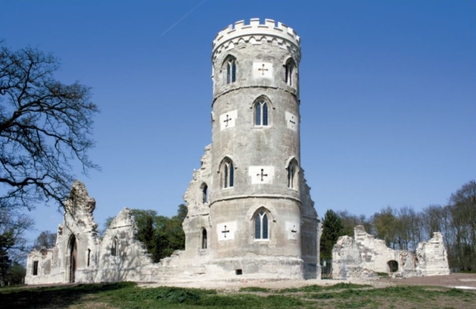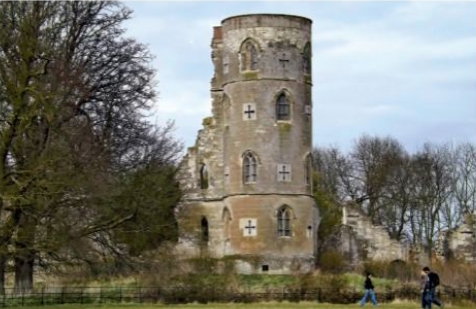Wimpole Gothic Tower conservation
This article originally appeared as ‘Wimpole: conserving a designed ruin’ in IHBC's Context 146, published in September 2016, written by Karen Teideman-Barrett.
Wimpole Gothic Tower, whose construction was overseen by James Essex and Lancelot ‘Capability’ Brown, raised the question of how to conserve a structure designed as a ruin.

|

|
| Wimpole Gothic Tower viewed from the south after conservation, with crenellations reinstated (Photo: Malcolm Barrett) | The tower before conservation (Photo: Malcolm Barrett) |
An afternoon stroll across the many layers of landscaped parkland of the Wimpole Estate in Cambridgeshire is now even more rewarding since the completion of urgent conservation and repairs to the 18th-century gothic folly. Today the Gothic Tower, with its main tower and two smaller towers linked by curtain walls, is particularly visible in the north parkland on the top of Johnsons Hill when glimpsed from the house, its milky stonework contrasting with the dense backdrop of tree cover. Visitors can once more walk freely around its walls.
This renewed access and completion of landscape works that re-present the folly in its 18th-century setting is particularly welcome this year as we celebrate the tercentenary of the birth of Lancelot ‘Capability’ Brown.
This would not have been possible two years earlier. The condition of the structure had severely deteriorated, the stonework had eroded, the main south tower was occupied by pigeons, doors and windows were boarded, the surrounding area was completely overgrown and the moat was blocked. The folly was susceptible to anti-social behaviour and was closed to the park’s many visitors for their own safety.
Following a 12-month conservation programme, the project was completed for the client, the National Trust, in April 2015 and the folly was officially opened in July of that year. The work has been achieved through funding from DEFRA’s Higher Level Stewardship scheme, administered by Natural England, and a combination of property reserves, legacy funding and donations.
The project works included below-ground archaeology, ground works to enhance and return the folly closer to its 18th-century setting, consolidation of the wall tops and soft clunch facing stone, and internal structural repairs to the main tower. Research from archival sources and from remaining fragments of the built structure informed the design of lost elements. This enabled the reinstatement of tower crenellations, leaded-light windows, external doors and a rear timber staircase. Alongside this work, further investigations commissioned by the trust included social history, wallpaper and paint analysis, and recording of graffiti that dates from 1772, the year of completion.
The proposal for a Gothic Tower at Wimpole originated in 1749 when the architect Sanderson Miller prepared a sketch for a designed ruin for Lord Hardwicke, owner of Wimpole Hall. It was intended to be an ‘eye-catcher’ visible across Wimpole Park and on a northern axis from the house. Miller’s design was not realised until some 25 years later, when the north park was remodelled by Lancelot ‘Capability’ Brown, who introduced a more ‘natural’ landscape. At this time, James Essex and Brown oversaw the construction of the Gothic Tower in its setting, against a backdrop of a screen of both deciduous and coniferous trees and fronted by a semi-circular moat. At the same time Brown’s new landscape could be viewed from the Prospect Room at the top of the Tower. The new clunch stone must have looked quite bright and new at the time, just as the new crenellations do today. This was commented on at the time by Jemima, Marchioness Grey.
Later, in 1805, Humphry Repton adapted the tower to provide living accommodation for the estate gamekeeper and his family, and added two intermediate floors to the tower and enclosed the open internal staircase. So the use of the tower changed from a folly in the landscape to a place of work for the gamekeeper, filled with outbuildings and animals, a use that continued until 1936. Following this period, under the ownership of the last private owner, Mrs Elsie Bambridge, the condition of the Gothic Tower deteriorated until subsequently the National Trust accepted the whole estate in 1976.
By the time the trust acquired Wimpole, the Gothic Tower was a building at risk. Some sections of walls had partially fallen, and the floor and roof of the tower had collapsed. Urgent repairs were carried out but the work was not able to extend to the reinstatement of the crenellations, so the parapet was built up in plain brickwork. Following the repairs in the late 1970s and early 1980s, and during the intervening years, the condition of the structure steadily worsened, the site was overgrown and the ground undermined by rabbits. The tower had to be fenced off to the public.
Since these earlier conservation repairs in 1980s by Purcell Miller Tritton, further funding opportunities have enabled the latest repair works to go ahead to secure the future of this significant parkland structure. The works have been developed and carried out by a specialist team with Donald Insall Associates as conservation architects and Cliveden Conservation as principal contractor.
The conservation works presented a number of philosophical and practical issues. First, how to conserve a structure designed as a ruin, where that ruin either does not follow the process of a built structure that will start to fall into ruin through time, or has been ruined through partial demolition; second, the act of re-instatement of lost elements. The stone conservation work at the tower included preventive decay, repair and restoration. Developing a programme of appropriate repair works initially involved both studying documentary evidence on the history of the site and site-based studies to record the condition and details remaining. For this we produced a management plan. Alongside this it was particularly important with a ‘ruined’ structure to understand the materials, performance and weathering qualities. The folly is a double-skin-wall construction, having an external visible face of clunch stone ashlar on to a rear red-brick backing. Finding the correct approach for the consolidation of the stonework was a key part of the repair process.
Clunch is a chalky limestone widely used in the south and east of England. It has significant porosity and its pattern of deterioration displays a characteristic lamination of the surface. Alongside detailed condition surveys mapping the decayed stone, a series of trials and investigations helped to evaluate the pattern of wetting and evaporation of the clunch stone at Wimpole, and to inform a specification for the works. Although a series of cleaning trials using different methods was carried out, it was decided that this did not significantly change the porosity of the stone.
The approach adopted for the existing clunch walls was:
- Cleaning: careful removal and de-frassing of loose material with brushes.
- Repair: raking out defective joints, repointing with appropriate mortar mixes. There were four mortar mixes using naturally hydraulic lime, for stone pointing of deep voids, stone pointing of fine joints, brick pointing and wall capping.
- Consolidation: applying limewash mix to individual stones, avoiding mortar joints that would act as a shelter coat. Different approaches to colour were used on the flank walls and on to the main tower, as that had a finer, crisper appearance. This treatment was applied to the clunch that had some surface lamination. Stones that retained a protective surface and that were covered by lichen were not treated.
On vulnerable wall tops, vegetation was removed and the stone was repointed to aid water run-off. Where new clunch stone was needed for repair works (this was minimal), local stone was sourced from the quarry at Barrington (now closed). The design for the reinstatement of the stone crenellations on the main tower was a painstaking exercise, involving close examination of archive photographs and of the remaining stonework at the tower top, and the preparation of a number of full-size drawings and mock-ups to achieve the correct proportion when viewed from the ground and from a distance across the park. It was decided to use Chilmark stone from the Chicksgrove quarry for the top weathering stones of the tower due to the exposed location. This has been successful alongside the clunch ashlar.
A principal aim of the project was to facilitate public access during the works to promote an understanding of the building, its conservation work and the landscape. This was managed with site tours, a visitor access scaffold and a volunteer group leading walks in the park. The public demonstrated much enthusiasm, engaging with the conservation work as it progressed.
The project has made a fundamental contribution to the significance of the Grade I registered park and garden at Wimpole. It has received the 2016 European Union Prize for Cultural Heritage and Europa Nostra Awards, is one of seven grand prix laureates, and it has received a commendation in the 2016 Civic Trust Awards for Conservation
This article originally appeared in IHBC's Context 146, published in September 2016. It was written by Karen Teideman-Barrett, project architect of the Wimpole Gothic Tower Project, an associate at Donald Insall Associates and a RIBA accredited specialist conservation architect.
--Institute of Historic Building Conservation
Related articles on Designing Buildings Wiki
- Archaeology.
- 2016 Natural Stone Awards.
- Building a Crossing Tower: a design for Rouen Cathedral of 1516.
- Clunch.
- Conservation.
- Conserving Ruchill Hospital water tower.
- Defects in stonework.
- Eyecatcher.
- Folly.
- Gardens Trust.
- IHBC articles.
- Lime mortar.
- National Trust.
- Principles of conservation.
- The Institute of Historic Building Conservation.
IHBC NewsBlog
Old Sarum fire in listed (& disputed) WW1 Hangar - Wiltshire Council has sought legal advice after fire engulfed a listed First World War hangar that was embroiled in a lengthy planning dispute.
UK Antarctic Heritage Trust launches ‘Virtual Visit’ website area
The Trust calls on people to 'Immerse yourself in our heritage – Making Antarctica Accessible'
Southend Council pledge to force Kursaal owners to maintain building
The Council has pledged to use ‘every tool in the toolbox’ if urgent repairs are not carried out.
HE’s Research Magazine publishes a major study of the heritage of England’s suburbs
The article traces the long evolution of an internal programme to research 200 years of suburban growth
IHBC Context 183 Wellbeing and Heritage published
The issue explores issues at the intersection of heritage and wellbeing.
SAVE celebrates 50 years of campaigning 1975-2025
SAVE Britain’s Heritage has announced events across the country to celebrate bringing new life to remarkable buildings.
IHBC Annual School 2025 - Shrewsbury 12-14 June
Themed Heritage in Context – Value: Plan: Change, join in-person or online.
200th Anniversary Celebration of the Modern Railway Planned
The Stockton & Darlington Railway opened on September 27, 1825.
Competence Framework Launched for Sustainability in the Built Environment
The Construction Industry Council (CIC) and the Edge have jointly published the framework.
Historic England Launches Wellbeing Strategy for Heritage
Whether through visiting, volunteering, learning or creative practice, engaging with heritage can strengthen confidence, resilience, hope and social connections.














